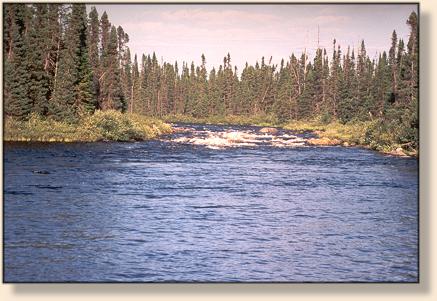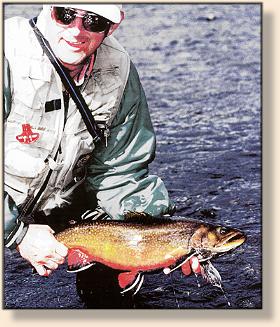Minipi Magic
IF YOU'RE IN THE MARKET FOR MONSTER BROOK TROUT ON A FLY,
LABRADOR'S MINIPI WATERSHED SHOULD BE A TOP CONSIDERATION
By Al Raychard
Photos by Dave Walker
Forty-five minutes out the Dehavilland Otter begins its gradual descent
on the south side of the Mealy Mountains, a spine of ancient granite
that separates southern Labrador from the rest of the world. Looking out
the window, a rather odd comparison between plane and the expanse of
black spruce, bog and water below crosses my mind. Both are old if not
jurassic, sometimes a bit rough around the edges and lacking the
comforts of home. And both are difficult to totally grasp and appreciate
at times, and they don't make either anymore. But both are a marvel and
dependable. The plane to get me where I want to go is like
nothing before or since and the bastion I am about to visit
is considered the best brook trout fishing on the planet. Somehow the
two compliment each other extremely well.
The Minipi watershed is actually a network of lakes connected
by a series of continuous thoroughfares, riffles and pools.
The 'river' is not large and anglers do not have to been expert
casters to work it successfully.

My destination is Little Minipi Lake, part of a complex system of
shallow tea-colored lakes and connecting thoroughfares, riffles and
rapids that drain 250 square miles of pristine wilderness 60-miles south
of Goose Bay, Labrador. It is not my first visit. Since the mid-'80's it
is probably my tenth, I'm not sure. What I am sure of is this. Since
landing my first five-pound brook trout from Quebec's Broadback River
big squaretails have been a part of my DNA. I think about them
constantly, dream about them, need them to complete who I am as a person
and fly fisherman. They have gotten under my skin, and having pursued
them from Manitoba across Canada through Ontario, Quebec to Labrador one
thing stands clear. Of the handful of major drainages where giant brook
are the so-called norm, the Broadback, Eastmain and Rupert in Quebec, the
Ashuanipi and Eagle in Labrador and God's in Manitoba, among few others,
the Minipi is unique. While large brook trout are caught elsewhere,
Minipi specimens average, average mind you, four to five pounds! Each
year an impressive number of examples in the six, seven, even
eight-pound range are also landed, plus a few tipping the scales at
10-pounds. According to the International Game Fish Association ( IGFA)
no place on the planet has produced more record brook trout.
The angling for trout of this size is consistent which is also
special. Many systems have peak periods or sporadic interludes when
trout measured in pounds rather than inches can be found. While the
Minipi system also has "peak" periods, such as in July and early August
before and during a specific or dominant hatch, monster squaretails can
be expected starting in late June right through the season in mid-September
even while blindcasting.
 The reason for this, perhaps, is Minipi's most unique feature of all.
The giant specks there grow to such humungous size on an exclusive diet
of aquatic insects; there are simply no minnows in the watershed, or at
least not enough to sufficiently contribute as forage or effect the
growth, health or size of its inhabitants. In essence, when you cast a
fly into Minipi waters you are fishing for pure insect eaters. While
streamers and bucktails work well, by far the best action comes on
imitations representing various life stages of insets, primarily nymphs,
wet flies and especially dry flies. For fly fishermen, particularly fans
and students of dry flies the Minipi is a more than a place to wet a
line, it is a state of mind. And let me affirm from personal experience,
nothing in freshwater angling quite compares with a wild brook trout of
such massive proportions rising and sucking in a dry fly as it floats on
peat-stained waters.
The reason for this, perhaps, is Minipi's most unique feature of all.
The giant specks there grow to such humungous size on an exclusive diet
of aquatic insects; there are simply no minnows in the watershed, or at
least not enough to sufficiently contribute as forage or effect the
growth, health or size of its inhabitants. In essence, when you cast a
fly into Minipi waters you are fishing for pure insect eaters. While
streamers and bucktails work well, by far the best action comes on
imitations representing various life stages of insets, primarily nymphs,
wet flies and especially dry flies. For fly fishermen, particularly fans
and students of dry flies the Minipi is a more than a place to wet a
line, it is a state of mind. And let me affirm from personal experience,
nothing in freshwater angling quite compares with a wild brook trout of
such massive proportions rising and sucking in a dry fly as it floats on
peat-stained waters.
In this day and age when the major brook trout strongholds are well
known and relatively easy to access, the Minipi stands out for another
reason. In a growing number of "trophy" brook trout areas the fishery as
a whole, or at least their numbers and average size, has declined.
In some, due to over-fishing and poor management by lodge
owners, finding a five pound brook trout is becoming somewhat difficult.
In others, trout of this size are still available, but not in the
numbers they were thirty years ago. Not true in the Minipi watershed.
First explored by the late Lee Wulff who pronounced it, "the finest
brook trout fishing in the world," the Minipi trout fishery remains as
healthy today as it was in the early 1960's when Wulff discovered it.
The reason for that fact is the way the fishery has been managed by camp
owners. Since the late 1960's only two fishing outfitters have ever
operated within the entire Minipi system, and from the beginning all
fishing was regulated to fly fishing only and anglers were limited to
one fish per trip. It seems those early camp owners were ahead of their
time. They realized early the Minipi trout resource, while unique, is
finite, and by establishing rules to protect it--long before it came
fashionable or politically-correct to do so, or before the catch and
release philosophy was popular--have indeed, protected one of the
angling world's great treasures. When Little Minipi Brook Trout
Camp was purchased by Labrador Outdoors in 1996 its owner, Harvey
Calden took those rules even further. Today, all fishing is with barbless
hooks and no fish may be retained. Fishermen can come and enjoy,
partake of the experience that Minipi has to offer, but they must leave
behind what Mother Nature bestowed. So it should be.
I found the place as I had left it, untouched, unspoiled and rolling
along at near perfect level. It all felt, smelled and looked so
familiar, as did the first riffle just in back of the lodge. About
halfway across, a particular rock just below the surface creates a series
of rooster tails. Just above, the water seems to stall momentarily
before pushing to each side and rolling downstream. I recognized the
spot immediately, for it was there on the last evening of my last trip I
hooked a five-pound male. That fact didn't surprise me. The spot always
holds a trout or two, and as I waited for my guide to prepare the boat
for our afternoon trip downstream I tied on a Humpy and gave it cast,
letting it come to rest well above the mark. Just above the rock, as the
current started to take hold, there was a boil and I immediately felt
resistance. The line went taut, the rod bent and before I knew it I was
following the prize through the rapids into the pool below. It wasn't a
monster, perhaps four pounds, but it was good to see things hadn't
changed.

Fishing on the Minipi is productive starting in late June right through
the season into early September. The action early comes best on wet
flies and streamers but I like to plan my visits in early July when the
system experiences its famous green-brown drake hatch. During that
period, swarms of Hexagenia emerge on the surface
on quiet days, and at times your artificial appears lost in the cloud.
On more than one occasion I have stood streamside marveled at the
spectacle as giant squaretails cruise like barracuda in the riffles, narrows
and pools gorging themselves. At such times fishing is often best
prior to the hatch, before trout get caught in the frenzy. I had come
armed with a good supply of Irresistibles, Humpies and Wulffs in
sizes 6, 8 and 10, patterns used to imitate the large mature Hexagenia,
as well as caddis variations, Cahills, Hornbergs, Woolly Worms, Woolly
Buggers, Muddlers, Sculpins and an assortment of nymphs in sizes
8 to 16 to accommodate other situations that might occur. We moved
downstream towards the "Char-Hole," a small riffle and pool just
upstream of a large lake where landlocked char appear in early
September--some exceeding 10-pounds--I knew I had come prepared.
One of the challenges of fishing Minipi, despite the numbers of large
trout, is the need for observation and accurate casting. The "river" is
not large. In some places any angler with developed casting skills can
throw a fly bank to bank. Even in areas where it runs wide or sprawls
and thins long casts are seldom required. It is an intimate, at times
friendly and easy place to work. But rarely are its inhabitants
forgiving, especially once fly lines appear overhead. "In wildenerss
waters, the brook trout is without guile," A.J.McClane writes in his
Game Fish of North America, but this is not always
true on the Minipi. Make a mistake and the inhabitants will let you
know. When it comes to presenting a fly, they often know what they
what they want, and where they want it.
What is often needed here is some pre-cast study, "reading" of the water
if you will. During the hatching season, July through the middle of
August, Minipi trout will often show themselves, either by a slow,
almost methodic rise, perhaps in a playful fashion, at other times in an
obvious if not aggressive fashion. Whatever the case, these displays
tell the angler where he or she wants to work a fly. Long casts are
seldom required, in fact are often less productive. Minipi trout, not
unlike brook trout in many wilderness bastions, are often found close,
at times literally at your feet or within a rods length from shore. This
not only increases the importance of observing before you cast, but
dictates some tact as well. Always keep in mind, while these trout tend
to lose some caution during a profuse hatch, even creating a great deal
of excitement as they make impressive swirls a rods length away,
spooking them is not difficult. My experience has been success comes
more consistently by hunting these fish first, making a careful approach
to within manageable casting limits before going to work. Blindcasting
works, surprisingly and pleasingly well at times, but there will be other
times when these trout refuse to move even if an offering appears a foot
away from their station. At those times knowing where they are
can make or break the day.
I knew all this as we approached the "Char Hole," and as my guide
secured the boat I stood back on a sandbar and studied the riffle and
pool below. The spot had proven a favorite over the years and I knew it
well. Some excellent fish occupy the middle riffle, but some of my
largest had been taken along the far bank, in a slow moving back eddy
beneath an overhanging spruce. To fish properly, it requires short casts at
first, gradually extending line and drifts as you work the bank downstream.
Typically, however, if things hadn't changed, the bigger fish occupy the top end
and take first dibs on available food, anything passing by going to
small counterparts just downstream. I had taken one of my largest Minipi
brook beneath those ancient firs, a 7-1/2 pound male, and it never
failed to provide action. Standing well back, it didn't take long before
I saw a trout slowly rise and suck in some matter and then disappear
without hardly a sign. Had I not had a history with the place, or
experience with Minipi trout, chances are I would have never given the
spot a second look.
Sneaking closer I made a cast, dropping the fly well above the mark. I
watched as it rode the surface, but reacted too quickly as the water
boiled. Instinctively, as the line lifted from the water I powered back
and immediately presented the fly in one motion, again well upstream.
This time the hook found its mark, and when the battle ended a
five-pound female lay cradled in my hands. I took a half dozen more
trout that first afternoon, all between four and six-pounds, and as we
fished other areas throughout the week, evening though I was to miss the
"Hex" hatch by a few days, I thanked the good Lord how some things never
change.

The Lodge at Little Minipi (above) is comfortable, warm, dry and set
in perhaps the premier brook trout drainage in the world. It offers
everything the fly fisherman seeking giant brook trout would want in
a pure wilderness setting. If you would like more information on
fishing Little Minipi Brook Trout Lodge contact: Labrador Outdoors,
P.O.Box 89, Jay, Maine 04239, or telephone: 1-888-244-7824.
Al Raychard
Our Man In Canada Archives
|




 The reason for this, perhaps, is Minipi's most unique feature of all.
The giant specks there grow to such humungous size on an exclusive diet
of aquatic insects; there are simply no minnows in the watershed, or at
least not enough to sufficiently contribute as forage or effect the
growth, health or size of its inhabitants. In essence, when you cast a
fly into Minipi waters you are fishing for pure insect eaters. While
streamers and bucktails work well, by far the best action comes on
imitations representing various life stages of insets, primarily nymphs,
wet flies and especially dry flies. For fly fishermen, particularly fans
and students of dry flies the Minipi is a more than a place to wet a
line, it is a state of mind. And let me affirm from personal experience,
nothing in freshwater angling quite compares with a wild brook trout of
such massive proportions rising and sucking in a dry fly as it floats on
peat-stained waters.
The reason for this, perhaps, is Minipi's most unique feature of all.
The giant specks there grow to such humungous size on an exclusive diet
of aquatic insects; there are simply no minnows in the watershed, or at
least not enough to sufficiently contribute as forage or effect the
growth, health or size of its inhabitants. In essence, when you cast a
fly into Minipi waters you are fishing for pure insect eaters. While
streamers and bucktails work well, by far the best action comes on
imitations representing various life stages of insets, primarily nymphs,
wet flies and especially dry flies. For fly fishermen, particularly fans
and students of dry flies the Minipi is a more than a place to wet a
line, it is a state of mind. And let me affirm from personal experience,
nothing in freshwater angling quite compares with a wild brook trout of
such massive proportions rising and sucking in a dry fly as it floats on
peat-stained waters.